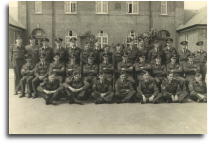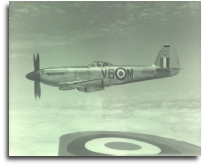
My father, John Leigh Parsons, known as Jack, was born in 1913 in Peckham, South London. He attended Wilson Grammar School and then worked as a bus driver for a church musical group before joining the Beckenham Electrical Company as an electrician.
He joined the Auxiliary Air Force in March 1938 and served in 615 Squadron (“County of Surrey”), his trade being an airframe fitter (FITT 2A). On 15th November 1939, 615 lined up at Croydon along with 607 Squadron to head for Merville following an inspection by 615's Honorary Air Commodore, Winston Churchill. Their Gladiators escorted the ground crews who flew in two Ensigns.
The Gladiators were replaced by Hurricanes in the latter half of April 1940, just as the Wehrmacht launched its offensive in the West. In the ensuing chaos, a lot of aircraft and equipment were abandoned as airfields were hurriedly evacuated. 615 Squadron operated from four aerodromes in eleven days, and as the British Expeditionary Force withdrew to Dunkirk, they only just made it back to England on the steamer “Biarritz” from Boulogne, arriving at Dover on 21st May. Jack told of how he was involved in blowing up his own squadron’s aircraft to stop them falling into enemy hands, and of how he took cover from a Stuka raid by hiding under a truck which turned out to be a fuel tanker. The Squadron returned to their base at RAF Kenley in Surrey and were assigned to No. 11 Group during the Battle of Britain when their Hurricane fighters played a key role in fending off the Luftwaffe assault in August 1940.
In September 1940, Jack was recommended for pilot training and was passed medically fit, but he evidently changed his mind in December. In March 1941, he was promoted to Technical Corporal and was transferred to the HQ Service Ferry Pool at Honeybourne then to Transport Command at RAF Lyneham in October 1942. We believe that he crewed Lancaster bombers being delivered to Egypt but this does not appear in the records, and it is not known if he ever flew combat missions. Between August 1943 and February 1945 he served at Hunsdon, Pershore, the Vickers Armstrong Factory and Hatfield before joining the HQ 44 Group once more at Lyneham. He was promoted to Technical Sergeant in December 1943 and was qualified on Wellington, Beaufort, Blenheim and Hudson bombers.
At the end of the war, the Royal Auxiliary Air Force was reactivated and Jack re-
Jack joined the Southern Aeroclub at Shoreham and learned to fly, gaining his private licence in 1955. He regularly flew Tiger Moths owned by the Wheel brothers, one of which still exists.
Jack died in May 1963.


615 Squadron, Tangmere 1950
(click image to expand)
A Mark 22 Spitfire flown by the CO, SQN LDR Peter Devitt.